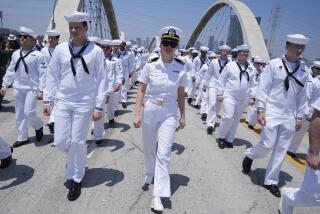A History Lesson on Slavery Sails In
CHICAGO â People groused about the heat and long wait and worried about the storm on the western horizon as Lake Michigan lapped at the wood hull of the Freedom Schooner Amistad.
On board, though, the complaining stopped and voices dropped to a whisper as visitors peered into the cargo hold of the replica of the 19th century vessel La Amistad, where 53 slaves were shackled in a cramped space before rebelling and taking over the ship.
They were eventually cleared of wrongdoing by the U.S. Supreme Court -- 18 years before the Emancipation Proclamation that freed the slaves.
âItâs very humbling,â said Renee Bonner, 49, as she stood beneath the rolled-up sails and swept-back masts of the ship. âImagine being chained down there, dying, because youâre black.â
More than two dozen classic sailing ships are anchored for a week along this cityâs lakefront and lining the Chicago River that runs through downtown in the largest gathering of so-called tall ships on the Great Lakes.
Thereâs a replica of the HMS Bounty, aboard which Fletcher Christian led historyâs most famous mutiny, another of the Nina, Christopher Columbusâ favorite vessel, and the Tarangini, powered by 10,000 square feet of sail.
None, however, appears to be luring more visitors than Amistad, which is neither the most spectacular nor famous of the ships. More than 5,300 boarded one recent day, virtually all seeming sobered by the story of the ship itâs modeled after.
âThey lived down there?â asked a 7-year-old girl named Shawna. âWas it dark?â
âYes,â a crew member said.
In early 1839, 53 people captured in West Africa and brought across the Atlantic Ocean aboard a Portuguese ship were sold in Havana to two Spaniards, Pedro Montez and Jose Ruiz. On about June 27, Montez and Ruiz shackled the Africans -- all but one male -- in the bowels of La Amistad for a trip to the Cuban city of Puerto Principe, where they planned to resell them.
Four days later, a captive named Senge Pieh, known as Cinque to his captors, used a nail to free himself and other slaves, who then overtook the ship and killed the captain and the cook. Two Africans also were killed in the uprising.
Not knowing how to sail or navigate, the men ordered Montez and Ruiz to take them home. Each morning, the Spaniards sailed very slowly east, toward the rising sun and Africa. At night, however, they secretly turned northwest and sailed more quickly.
Two months after leaving Cuba, La Amistad sailed into Montauk Point, Long Island, where the vessel was seized by the U.S. Navy. The Africans -- six more of whom had died during the journey -- eventually went on trial for murder. After being vindicated, most returned to Africa.
Although the story would be largely overlooked by historians -- Steven Spielbergâs 1997 film âAmistadâ told it to a large audience for the first time -- the trials at the time became the focus of abolitionists and slavery supporters alike.
In 1841, former President John Quincy Adams successfully defended the slaves before the U.S. Supreme Court, which ruled that the Africans had been illegally enslaved and thus justified in their rebellion.
The decision did not directly challenge the institution of slavery. But for the first time the Supreme Court suggested that blacks were entitled to the same rights as whites.
The replica anchored at Chicagoâs Navy Pier was built between 1998 and 2000 by Amistad America Inc., a nonprofit education group. It is a simple, spartan vessel with a deck just 23 feet wide and 82 feet long. It seems incapable of holding 53 slaves and a crew -- and the original was actually 10 feet shorter, six feet narrower and had no railing.
âI feel proud of the people who endured this,â said Evelyn Floyd, 57. âI couldnât have made it, but my ancestors did.â
As the storm arrived this recent day, pouring rain, the crowd thinned but the shipâs master, Bill Pinckney, stood and chatted with those who stayed. The 67-year-old sailor is among an elite group who have circumnavigated the globe alone -- and is the first African American to do so.
âThis is an extremely well-turned-out piece of wood, you might say, and a special one,â Pinckney said.
The ship will head to Indiana when it weighs anchor Aug. 13, and then will sail on to Detroit and a series of other ports on the Great Lakes before settling in at Bostonâs Fan Pier in mid-October.
âThis ship isnât going to change the world, but for a brief period of time people who donât usually get together have conversations about the past, about how we could live closer to our ideals,â Pinckney said.
âThey walk together in the steps of 19th century sailors ... and of slaves.â
More to Read
Sign up for The Wild
Weâll help you find the best places to hike, bike and run, as well as the perfect silent spots for meditation and yoga.
You may occasionally receive promotional content from the Los Angeles Times.






